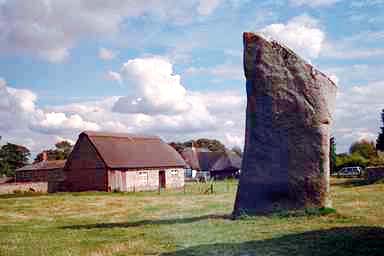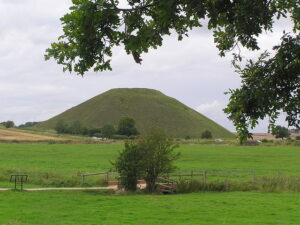A Lady in Waiting: An explanation of the Avebury Complex
 4,500 years ago at what is now known as Avebury in Wiltshire, Neolithic man erected a vast stone circle (the Great Circle) many times larger than the more publicised Stonehenge twenty miles to the south. Surrounding the outside of these 100 or so sarsen stones is a huge partly silted-up ditch some thirty feet deep thus classifying it today as a henge site. So big was the circle that much of the modern-day village of Avebury lays within its circumference of four-fifths of a mile. To say it is only impressive is to underestimate its grandeur.
4,500 years ago at what is now known as Avebury in Wiltshire, Neolithic man erected a vast stone circle (the Great Circle) many times larger than the more publicised Stonehenge twenty miles to the south. Surrounding the outside of these 100 or so sarsen stones is a huge partly silted-up ditch some thirty feet deep thus classifying it today as a henge site. So big was the circle that much of the modern-day village of Avebury lays within its circumference of four-fifths of a mile. To say it is only impressive is to underestimate its grandeur.
Joined to the Great Circle were two double rows of standing stones known today as the West Kennet and Beckhampton Avenues. The West Kennet Avenue was nearly one and half miles in length but the now all but missing Beckhampton Avenue’s termination point is presently unknown although believed to have been similar in length.
At the farthest end of the West Kennet Avenue and connected to it, is the site of a now destroyed set of stone and timber circles known as the Sanctuary and this lies on Overton Hill alongside the oldest and longest track-way in the British Isles – the Ridgeway Path.
 Three quarters of a mile to the south of the Great Circle was built the enigmatic Silbury Hill, the largest man-made hill in Europe with a huge surrounding 20ft deep ditch now mainly silted up. Covering a ground area of five and a half acres it is 130ft high with some estimates claiming it took some 18 million man hours to build using nothing more than antler picks and the shoulder blades of Oxen and wooden tools. Running north to south from Avebury is the Avebury Winterbourne stream which merges with the River Kennet to the south of Silbury Hill.
Three quarters of a mile to the south of the Great Circle was built the enigmatic Silbury Hill, the largest man-made hill in Europe with a huge surrounding 20ft deep ditch now mainly silted up. Covering a ground area of five and a half acres it is 130ft high with some estimates claiming it took some 18 million man hours to build using nothing more than antler picks and the shoulder blades of Oxen and wooden tools. Running north to south from Avebury is the Avebury Winterbourne stream which merges with the River Kennet to the south of Silbury Hill.
Also just below Silbury Hill lie the Swallowhead Springs where the main River Kennet rises. A quarter of a mile further south on the top of rising ground is the West Kennet Long Barrow, a chambered Early Neolithic chambered burial tomb believed to have been in use some 1,000 years prior to the construction of the other megaliths in the area.
These combined man-made structures are known collectively as the Avebury Complex and it has been classified as a World Heritage Site such is its importance. However, even after many excavations have taken place at the Great Circle, the Avenues, the Sanctuary and Silbury Hill, no practical or tangible theories or understanding of why they were built and what they were used for on completion has been put forward – until now that is! They had remained as much a mystery as when the first known official excavation began back in the 17th century.
After some 30 years investigating the Complex, stone circle researcher Roy Goutté has reached some amazing conclusions that he says will change our understanding of Neolithic man in Great Britain and their beliefs for ever if correct. No longer will the Great Circle at Avebury, or Stonehenge for that matter, be seen as ‘stand alone’ structures, but part of huge complexes. It is by reaching this understanding that we can now begin to decipher their true meaning.
Working systematically through eight individual man-made or natural parts of the Avebury Complex as he sees it, he has now intrinsically linked them to show that they were all interconnected to form a huge hitherto unrecognised Female Earth Figure laid out over hundreds of acres of the Wiltshire countryside and has written a book on his discoveries. The Work is titled ‘A Lady In Waiting’ and clearly shows that this figure was designed and built in the Late Neolithic period. Roy Goutté firmly believes it was built with one aim in mind…to lead the Souls of the Dead into their Afterlife and his book guides the reader through the various stages of the Neolithic transition from this world into the next!
Contemporary with the building of the Great Pyramid at Giza and the Egyptian belief in the Afterlife, Roy Goutté has been able to show that it wasn’t just the hierarchy of its time that benefitted from the promise of an Afterlife at Avebury, but everybody, for he believes that the Earth Figure was built by the people, for the people. How it functioned and how it all worked in the mindset of Neolithic man is clearly shown by the intricate layout of the figure and how it used the natural waterways which ran through the figure’s body to bring it ‘alive’ to them by representing its Lifeblood.
The Swallowhead Springs were a representation of the birth canal with the New Life emerging from the womb which was itself represented by Silbury Hill with its water filled ditch symbolically representing the ‘waters’ around the unborn Spirit while awaiting its emergence into the Afterlife. The Stone Avenues were the arms of the Figure and the Sanctuary at the conclusion of the West Kennet Avenue the Gathering Hand alongside the Ridgeway Path where the burial ground, mortuary house and drying-out platforms were situated and from where the Afterlife journey began. The Ridgeway Path was the route that led directly to the Sanctuary and would have been witness to much sadness as dead or dying people were carried or walked to their last earthly resting place prior to beginning their journey into the Afterlife.
The Great Circle was of course the Head of the Figure and the two smaller stone circles within it the Eyes. It had a Mouth which ringed a Sacred Well that is still in evidence today.
In all it is an astounding discovery and the actual layout of the Figure showing all the relevant parts can quite clearly be seen on the overdrawn map within the book or on the Lady In Waiting website along with over 50 photographs of those component parts. In all, the book is innovative and groundbreaking and more importantly, very plausible if one reverts to a way of thinking not seen since Neolithic times.
Roy Goutté concludes his book with the words:-
‘Nearly everything that should be there still is – the only things really missing are the people and their beliefs’.
And he’s right and I’m sure that after reading this book you too will think again about the true meaning of the Avebury Complex.
More details about the book can be found at the Lady In Waiting website:- http://aveburyaladyinwaiting.co.uk/
About the Author
Roy Goutté was born in the Channel Island of Jersey, but now lives in Cornwall on the edge of Bodmin Moor with his wife and their two sons.
His interest in the past began as a child when growing up in the south-east of the island where many of his early boyhood days were spent playing around such important sites as the passage graves at La Hougue Bie in the parish of Grouville; La Pouquelaye de Faldouet in the parish of St Martin; Mont Ubé at St Clement and the gallery grave Le Dolmen du Couperon at St Martin. At the time they were just places to have fun in on days out, but as he matured he began to take more interest in them for what they really were and not just as playgrounds.
After leaving Jersey he became a regular visitor to Stonehenge and Avebury as his interest had moved to mainly investigating stone circles. Access to Stonehenge then became so limited that he felt it restricted his investigations there, so he concentrated solely on Avebury. He had been working on a theory that both Stonehenge and Avebury were not ‘stand-alone’ sites like many thought, but part of huge complexes, so this gave him good reason to investigate Avebury fully and without distraction.
Working alone, his dedicated research into the Avebury Complex has resulted in this – A Lady In Waiting – his first archaeological style book investigating an ancient wonder that has captured the imagination of people since the days of such notable antiquaries as John Aubrey in the 17th century and William Stukeley in the 18th.
Roy Goutté is also the author of eight previously published books in the Principal Lines series on the bloodlines of the Border Collie in various disciplines – and an Obedience dog training book – Get It Right.
Photo credits:
Silbury Hill: Dave Yates, CC BY-SA 3.0, via Wikimedia Commons
